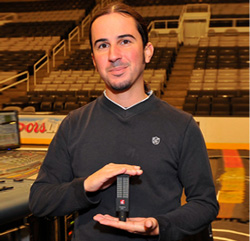
Eddie Mapp, front of house engineer with alt-rock/pop band Paramore, is using three sE Electronics Voodoo VR1 ribbon microphones and a pair of patented IRF2 instrument reflexion filters with the band on tour.
Paramore is currently playing arenas in Latin America before heading to Europe for a month in support of its self-titled fourth album, which made its debut at #1 on the U.S. Billboard 200 chart in April.
Mapp is using the VR1s on the electric guitar rigs in the live line-up, where three touring musicians supplement the three-piece band.
“Each of the three guitar players has a clean guitar rig and a distorted guitar rig; I’ve got the VR1s on the distorted cabinets as well as Taylor’s clean amp,” explains Mapp.
Although the three guitarists—band member Taylor York, his brother Justin York and multi-instrumentalist Jon Howard—prefer more traditional dynamic or condenser mics with a little faster reacting top end for their in-ear monitor mixes, says Mapp, “I like to tune my PA as a nice linear system, so it’s nice to have a flat microphone like the VR1 where I can place the high-end emphasis wherever I need it out front and the ribbon element really helps it sit in the mix with out over powering the vocal in the upper mid range.”
He adds, “I’ve always liked ribbon microphones and mainly used them more in the studio as room mics and for different applications. But I hadn’t used them a lot on guitar in the past just because of the lack of top end.”
The Voodoo VR1, however, corrects that typical ribbon microphone characteristic through the use of a patent pending mechanical device designed by Siwei Zou, CEO of sE Electronics that enables a flat response from 20 Hz through 20 kHz.
“The VR1 is super-sturdy, it takes EQ really well and I like the fact that it does go down really low—lower than I normally need for the show,” Mapp continues. “There are certain parts in the show where maybe the guitar does a little ‘dive-bomb’ and I take out the high-pass filter and push it up. It’s really fun, the way it just fills the room.”
Mapp also enjoys the low-mid push that the VR1 provides, especially when using them on outdoor shows. “I think perhaps because you don’t have the room pushing back against them, sometimes you don’t get the same feel of the guitars outdoors. But with the amount of usable low-mid in the VR1, outdoors I’ll sometimes leave a little bit more of it on the guitars, which just makes them sound gigantic.”
Mapp, who has also worked with bands such as Taking Back Sunday, Evanescence and Stone Temple Pilots, first heard about the Voodoo VR1 from two fellow touring FOH engineers: “It was Andy Meyer, who mixes Mötley Crüe and Justin Timberlake, and [Ken] Pooch [Van Druten], who mixes Linkin Park—they had both started using the VR1 and recommended that I check it out. I just fell in love with the thing.”
As for the positioning of the VR1 mics, he adds, “In the studio I tried miking the cabinet dead center and then on the edge of the speaker. At first I really liked the sound just on the edge of the dust cover, but I found that in context with everything it cuts a little better right in the middle.”
Mapp uses z-bars to position the VR1s on each cabinet, and has adapted hardware to allow him to also position IRF2 filters on two of the rigs. “The two upstage guitar players both have rear-facing cabinets, so I’m using IRF2 filters on those, especially when we’re playing smaller places with a close back wall, just to eliminate that first reflection. I try to keep everything on stage as isolated as possible because I’m already sending it out into this giant, ambient space.”
